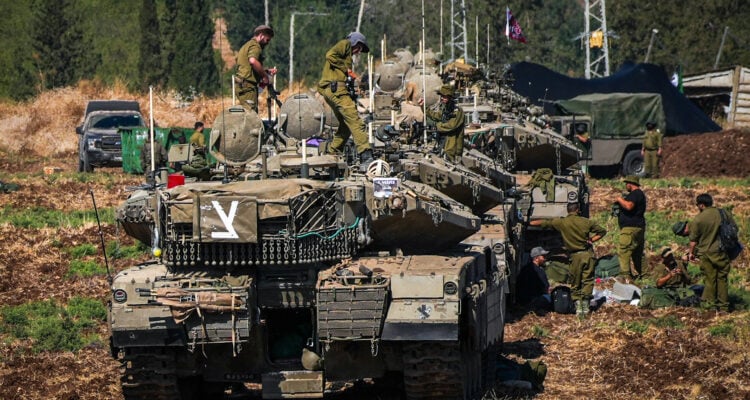The 155-millimeter shells are propelled by explosive guided by targeting crews to make sure the firepower is directed at Hezbollah.
By Yaakov Lappin, JNS
Israel Defense Forces Artillery Corps units, which stand guard in the country’s north and south, ready at a moment’s notice to rain fire on the enemy, are the last thing Hezbollah and Hamas want to face across a battlefield.
Although not often in the headlines, without the relentless work of these battalions, Israel’s ongoing ground operations against Hezbollah in Lebanon and Hamas in Gaza would not be possible, and northern Israel would be facing many more deadly rocket attacks today.
On Tuesday, JNS joined the 405 Artillery Battery of the 411st Battalion, which is a part of the 282nd Fire Brigade.
This battalion has been providing crucial firepower support for IDF forces in Lebanon, their shells acting as pillars of fire and smoke before the camp, while also playing a critical role in defending Israel’s northern towns and villages.
Under a warm fall sun and the regular threat of Hezbollah rocket fire, the battery’s soldiers and officers prepared, as they do every day, their 155-millimeter self-propelled artillery guns for rapid action.
Readiness is critical for this unit, which must be able to provide fire support for ground forces within seconds of receiving the request, as well as respond to intelligence from a variety of sources on Hezbollah targets.

Capt. Guy, commander of 405 Battery in the IDF Artillery Corps’ 411th Battalion. Credit: IDF Spokesperson’s Office.
“Before I came here, for the past seven years I hadn’t fired a single real shell, only in exercises. The soldiers here now began firing real shells on their third or fourth day here, on behalf of the forces in the field,” Capt. Guy (full name withheld), the battery commander.
“Ultimately, what we’re doing here is conducting missions to destroy the enemy, which is trying to fire on our maneuvering forces or launch rockets into Israeli territory,” he added.
Tragically, that threat materialized later the same day when a civilian was killed by a Hezbollah rocket in the town of Ma’alot Tarshiha, several kilometers from the border.
However, many such threats have been thwarted and destroyed by the Artillery Corps. Capt. Guy explained that a rapid sensor-to-shooter cycle is the key.
The 155 millimeter shells are propelled by explosives, and while considered to be “statistical” (not precision-guided) weapons, the computer-controlled gun barrels and the targeting crews make sure the firepower is directed at Hezbollah.
Sometimes, the battalion launches smoke shells to provide screens for maneuvering forces. Other times, they fire illumination shells that light up the battlefield. The shells can reach targets some 30 kilometers (18.6 miles) away.
Soldiers here “know they can go to sleep at night, wake up at 4 a.m., start firing shells to complete the [sensor to shooter] cycle quickly, and go back to sleep,” said Capt. Guy. “Twenty minutes later, they can be scrambled again,” he added.
“I had an event here where I headed out for an exercise with the entire battery, we left the sector, and suddenly at 2:30 a.m. I was told we have a firing incident. One of the IDF units had entered Lebanon, and suddenly we went from an exercise to firing tens of shells,” he recalled.
The artillery units interact with the rest of the ground forces using the IDF’s combat network system, known as Torch X, which displays, in real time, the location of friendly and enemy forces.
A liaison soldier from a division requiring assistance often passes on a request for fire support and gives enemy position data. The battery’s soldiers then run calculations before sending the data to the guns.
“Our intelligence, as opposed to Oct. 7 [2023] when it failed, is working today in a phenomenal manner, both here and in Gaza,” said Capt. Guy.
The battery regularly receives targeting data on enemy rocket squads on their way to attack Israel. Thwarting these attacks requires both speed and accuracy.
Shells not only pose a direct threat to enemy forces, they also keep the enemy pinned down,” the captain explained.
“No one wants to move from where they are, lying on the ground or underground, when 155-millimeter shells are falling,” he said. The statistical nature of the weapons contribute to this pinning effect, he added.
“Hezbollah has all of its weapons ready underground. They head out to conduct fire, but once we close the cycle quickly, they lose motivation,” he said. The unit has also struck rocket launchers.
If sensitive civilian sites like schools and mosques are near the targets, the unit carefully conducts checks to receive approval, and ensures that the area is almost entirely empty of civilians.
“We know, and it’s no secret, that in some of the villages, civilian sites have been used as combat infrastructure … and in those cases they were destroyed,” he said. “But those cases first needed approval.”
The 411 Battalion arrived in the north from Gaza in February, and has since been fighting Hezbollah.
The battalion was the first artillery unit to cross the border into Gaza (rather than firing from within Israeli territory) in a decade, which carried additional risk.
“Here too, we are ready for any scenario,” he added. Hezbollah would dearly like to hit positions such as this, and has repeatedly attempted to do so.

Cpl. Mia, a member of the IDF’s 411th Artillery Battalion, in northern Israel on Oct. 29, 2024. Credit: IDF Spokesperson’s Office.
Cpl. Mia, 20, who emigrated to Israel from the United States and enlisted in the IDF after the Oct. 7 massacre, shared some of her operational experiences with JNS.
“Over eight months ago, we arrived in the north after being active in southern Gaza for four months,” she said.
“We’re firing shells here every day, assisting forces on the ground. It’s easy to lose morale because we are not like the forces on the ground that see everything with their own eyes and understand the significance of what they are doing, but we are truly doing very significant things,” she added.
“The forces speak to us over the communications network and thank us for what we are doing. We are saving them, and getting them out of danger.”
In recent weeks, she recalled, a maneuvering force in Lebanon came under Hezbollah fire, and within a minute a smoke shell was in the air, providing life-threatening cover.
“We heard a couple of days later that we really saved them, and that without this, the entire incident would have turned out very differently. It was very moving to hear this. To hear that what we are doing on the ground is really significant,” she added.





